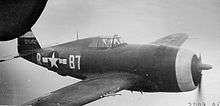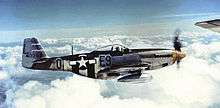361st Fighter Group
| 361st Fighter Group | |
|---|---|
|
361st Fighter Group Insignia | |
| Active | 1943–1945 |
| Country |
|
| Branch | United States Army Air Forces |
| Type | Fighter |
| Part of | Eighth Air Force |
| Garrison/HQ | European Theatre of World War II |
| Nickname(s) | Yellow Jackets |
The 361st Fighter Group was a World War II United States Army Air Forces combat organization. It served primarily in the European Theatre of World War II.
During World War II the group was an Eighth Air Force fighter unit stationed in England. Primarily assigned to RAF Little Walden in 1943. It claimed 226 air and 105 ground aircraft destroyed. It flew its last mission on 20 April 1945.
During the Cold War the unit was redesignated as the 127th Fighter Group, and allotted to the Michigan Air National Guard. Today, the 127th Wing is a part of the USA's national defense, being part of the United States Air Force Air Combat Command's First Air Force.

History
Lineage
- Constituted as 361st Fighter Group on 28 January 1943
- Activated on 10 February 1943
- Inactivated on 10 November 1945
- Redesignated 127th Fighter Group and allotted to National Guard (Mich) on 24 May 1946
Assignments
|
|
Operational Units
- 374th Fighter Squadron (B7) 10 February 1943 – 24 October 1945
- 375th Fighter Squadron (E2) 10 February 1943 – 24 October 1945
- 376th Fighter Squadron (E9) 10 February 1943 – 24 October 1945
Aircraft flown
Stations assigned
|
|
Operational history
World War II
Constituted as 361st Fighter Group on 28 January 1943. Activated on 10 February 1943. Joined Eighth AF at RAF Bottisham, England in November 1943. The group was under the command of the 65th Fighter Wing of the VIII Fighter Command. Aircraft of the group were identified by yellow around their cowlings and tails.



The 361st FG entered combat with P-47 aircraft on 21 January 1944 and converted to P-51's in May 1944. The unit served primarily as an escort organization, covering the penetration, attack, and withdrawal of B-17/B-24 bomber formations that the USAAF sent against targets on the Continent.
The group also engaged in counter-air patrols, fighter sweeps, and strafing and dive-bombing missions. Attacked such targets as airdromes, marshaling yards, missile sites, industrial areas, ordnance depots, oil refineries, trains, and highways. During its operations, the unit participated in the assault against the German Air Force and aircraft industry during the Big Week, 20–25 February 1944, and the attack on transportation facilities prior to the Normandy invasion and support of the invasion forces thereafter, including the Saint-Lô breakthrough in July.
The weight of the heavy P-47 fighters soon began to tell on the wet surface making take-offs tricky. A team of American engineers were called in during January 1944 and, in three days, they constructed a 1,470-yard-long runway with pierced-steel planking. This feat was considered a record for laying this type of prefabricated surfacing. The runway, which was aligned NE-SW, became the main at Bottisham the other also being constructed of PSP.
In September 1944 the 361st FG moved to RAF Little Walden. At Little Walden, the 361st served primarily as a B-17/B-24 escort organization, covering the penetration, attack, and withdrawal of bomber formations that the USAAF sent against targets on the Continent. The group also engaged in counter-air patrols, fighter sweeps, and strafing and dive-bombing missions. Attacked such targets as airfields, marshaling yards, missile sites, industrial areas, ordnance depots, oil refineries, trains, and highways.
The group supported the airborne attack on the Netherlands in September 1944 and deployed to Chievres Airdrome, (ALG A-84), Belgium between February and April 1945 flying tactical ground support missions during the airborne assault across the Rhine.
The unit returned to RAF Little Walden and flew its last combat mission on 20 April 1945.
On 10 November the 361st Fighter Group returned to Camp Kilmer New Jersey and was inactivated.
Cold War
During the Cold War the unit was redesignated as the 127th Fighter Group, and allocated to the Michigan Air National Guard on 24 May 1946.
The group was ordered into active service on 1 February 1951 as a result of the Korean War and assigned to Air Training Command. In March 1951 it was redesignated as the 127th Pilot Training Group, being assigned F-51 Mustangs, F-80 Shooting Stars and F-84 Thunderjets while serving as a training organization.
The 127th was relieved from active duty in November 1952 and redesignated the 127th Fighter Group.
References
![]() This article incorporates public domain material from the Air Force Historical Research Agency website http://www.afhra.af.mil/.
This article incorporates public domain material from the Air Force Historical Research Agency website http://www.afhra.af.mil/.
Notes
Bibliography
- Cora, Paul B. Yellowjackets! The 361st Fighter Group in World War II P-51 Mustangs over Germany. Atglen, Pennsylvania: Schiffer Publishing, 2002. ISBN 0-7643-1466-1.
- Freeman, Roger A. Airfields of the Eighth: Then and Now. After the Battle, 1978. ISBN 0-900913-09-6.
- Freeman, Roger A. The Mighty Eighth The Colour Record. Cassell & Co., 1991 ISBN 0-304-35708-1.
- Gotts, Steve. Little Friends: A Pictorial History of the 361st Fighter Group in WW II. Dallas, Texas: Taylor Publishing Company, 1993.
- Maurer, Maurer. Air Force Combat Units Of World War II. Maxwell AFB, Alabama: Office of Air Force History, 1983. ISBN 0-89201-092-4.
.jpg)
.svg.png)